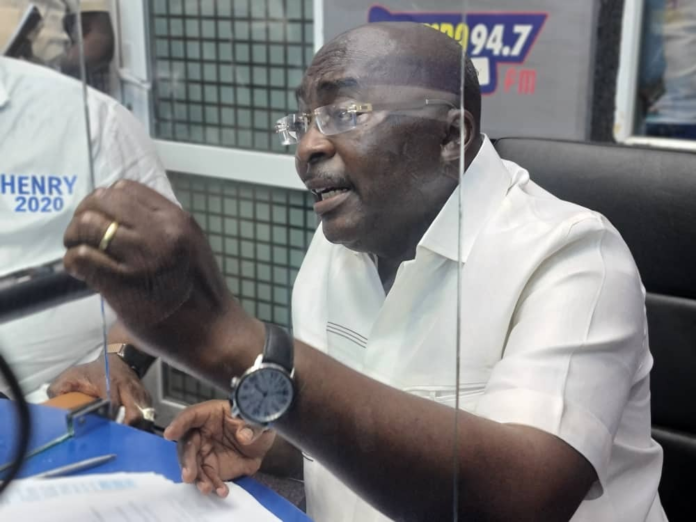
Vice President, Dr. Mahamudu Bawumia has made a comparison of debt accumulation under the opposition National Democratic Congress (NDC) and the New Patriotic Party (NPP).
His comparison of debt accumulation rate under the two dominant political parties followed a question posed to him by OB, host of the Ekosii Sen political afternoon programme over which political party had added more debts to the nations’ debt stock.
Debt accumulation rate from 2008 – 2019
According to the Vice President, the NPP government has properly managed the rising debt stock of the country.
He asserted that, the high levels of inflation, interest rate, the exchange rate as well as the instability of the macroeconomy seen under the NDC government from 2008 to 2016, was as a result of the fast increasing rate in debt accumulation by the NDC government.
Dr Bawumia posited that, the increase in debt stock from 2008 to 2012 was 267 per cent, from 2012 to 2016 it increased by 243 per cent.
However, the public debt stock under the management of the NPP from 2016 to 2019 has increased by 76 per cent.
Ghana’s public debt currently stands at GH₵263 billion cedis, representing 68.3 per cent of Gross Domestic Product (GDP).
An increase of almost 6 per cent from end-December 2019 debt stock which was 62.4 per cent of GDP.
Budget deficit has also increased to 7.4 per cent from a revised target of 7.2 per cent.
According to the Vice President, costs incurred by government in the banking sector clean-up, the various reliefs given by the government during the Covid-19 pandemic have all attributed to the increase in the public debt stock.
Rate of debt-to-GDP ratio slowed
The Vice President noted that, the debt-to-GDP ratio had also been slowed by the NPP government.
He asserted that, the rate of debt-to-GDP ratio under the NDC from 2008 to 2012 was 49 per cent, and 19 per cent from 2012 to 2016.
“But under the NPP, the rate of debt-to-GDP ratio is 3.9 per cent excluding the financial sector clean-up and 9.3 per cent including the financial sector clean-up,” he stated.
In addition, he stated that interest rate payments on public debts had reduced from 6.9 per cent of GDP to 5.9 per cent, reflecting a reduced rate of debt accumulation.
“We were previously using 6.9 per cent of the nation’s revenue to pay interests on debts, but now it has been reduced to 5.9 per cent. We have elongated the yield curve as far as public debt is concerned and we are now able to bear the burden of interest payments on debts because we have shifted from short term interest payments to long term interest payments,” he noted.
Cedi depreciation
On the depreciation of the cedi against the dollar, Dr Bawumia noted that the cedi had performed very well against the dollar for this year as compared to the previous years.
The cedi for this year, has cumulatively depreciated by 2.9 per cent against the dollar, losing just 24 pesewas to the dollar.
Dr Bawumia commended the Governor of the Central Bank, Dr Ernest Addison for the ‘sterling performance’ of the cedi.
“An annual depreciation of a little over 2 percent is amazing, we are one of the best performing currencies against the dollar currently and there is now a lot more confidence in the management of the economy,” he stated.
Historical performance of the cedi against the dollar since 2015
2019 12.9% depreciation
2018 8.4% depreciation
2017 4.9% depreciation
2016 9.6% depreciation
2015 18.75% depreciation

![Let them continue making noise – Agona West NPP PC fires back after suspension [Listen]](https://www.adomonline.com/wp-content/uploads/2025/07/images-Copy-218x150.jpg)


![We’ll win Akwatia by-election – Mustapha Gbande declares [Video]](https://www.adomonline.com/wp-content/uploads/2025/07/1000471849-218x150.jpg)
![I’m not afraid of anyone in the NPP – Mustapha Gbande [Video]](https://www.adomonline.com/wp-content/uploads/2025/07/1000471850-218x150.jpg)
![Ablekuma North: If any NDC boy is harmed, we’ll hold you responsible – Gbande warns NPP [Video]](https://www.adomonline.com/wp-content/uploads/2025/07/1000471871-218x150.jpg)